“The Fascinating Life Cycle Of Bromeliads Explained”
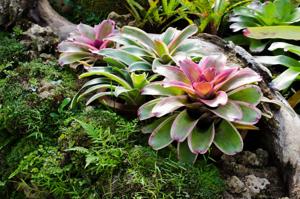
Introduction to Bromeliads: Discovering a Botanical Wonder
Bromeliads represent one of the most diverse plant families in the botanical world. It offers an array of shapes and survival strategies. These extraordinary plants have captured the imagination of botanists and nature enthusiasts alike.
What Are Bromeliads?
Bromeliads are a family of flowering plants characterized by their:
- Adaptability to diverse environments
- Water storage capabilities
- Distinctive leaf structures
- Ability to thrive in challenging conditions
Historical Overview
The story of bromeliads begins in the tropical and subtropical regions of the Americas. Their evolutionary history dates back millions of years. Indigenous cultures first recognized the plants’ remarkable properties. Using them for:
- Medicinal purposes
- Food production
- Ceremonial practices
- Building materials
Unique Characteristics of Bromeliads
What sets bromeliads apart from other plants is their ability to:
- Survive in environments ranging from rainforest canopies to arid landscapes
- Collect and store water in their central cup or “tank”
- Adapt to minimal soil nutrients
- Develop complex relationships with surrounding ecosystems
Global Distribution and Popularity
Bromeliads have spread across continents, with:
- Approximately 3,500 known species
- Concentrations in Central and South America
- Growing popularity in global horticulture
- Recognition for their ecological importance
Why Bromeliads Matter
These plants play critical roles in:
- Providing habitat for small animals
- Supporting biodiversity
- Demonstrating plant adaptation strategies
- Offering scientific insights into plant survival mechanisms
Botanical Classification of Bromeliads: Understanding Their Scientific Identity
Bromeliads represent a botanical family that showcases scientific complexity. Let’s dive deep into the intricacies that define these plants.
Scientific Taxonomy
The bromeliad family is known as Bromeliaceae. They belong to the following taxonomic hierarchy:
- Kingdom: Plantae
- Division: Magnoliophyta
- Class: Liliopsida
- Order: Poales
- Family: Bromeliaceae
Major Bromeliad Families
The Bromeliaceae family is divided into several subfamilies:
- Bromelioideae: Including pineapple and many ornamental varieties
- Tillandsioideae: Known for epiphytic air plants
- Pitcairnioideae: Primarily found in more arid and rocky environments
Diversity of Bromeliad Species
Bromeliads exhibit diversity, with:
- Over 3,500 identified species
- 58 recognized genera
- Habitats span from sea level to high mountain regions
- Variations in size from tiny 1-inch air plants to 30-foot landscape specimens
Unique Botanical Characteristics
Bromeliads distinguish themselves by several botanical features:
- Specialized Leaf Structures: Typically arranged in a rosette pattern
- Water-Storing Capabilities: Central cup design for capturing and storing moisture
- Trichome-Rich Surfaces: Specialized hair-like structures that assist in water absorption
- Adaptive Root Systems: Minimal and used for anchoring rather than extensive nutrient collection
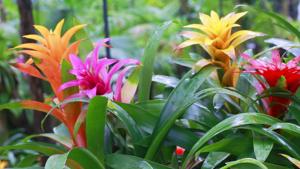
Types of Bromeliads: An Exploration of Nature’s Diversity
A. Popular Bromeliad Varieties
Bromeliads encompass an incredible range of species. Each species has its own characteristics and aesthetic appeal. Some of the notable varieties:
Tillandsia (Air Plants)
- Unique Growing Characteristics: Grow without soil, absorbing nutrients and moisture through specialized leaves
- Native to forests, mountains, and deserts of Central and South America
- Adaptability to various environments
- Popular in modern interior design and botanical collections
Guzmania
- Known for dramatic, colorful flower spikes
- Primarily epiphytic species
- Vibrant colors including red, orange, and yellow
- Excellent indoor plants with low maintenance requirements
Aechmea
- Distinctive urn-shaped growth pattern
- Striking inflorescences that can last for months
- Popular in tropical and subtropical landscaping
- Many varieties feature dramatic color variations
Pineapple (Ananas comosus)
- The most recognized bromeliad
- Agricultural and economic significance
- Originated in South America
- Demonstrates the family’s versatility
Vriesea
- Characterized by sword-like leaves
- Impressive flower spikes in bright colors
- Used in tropical garden designs
- Excellent for indoor and outdoor cultivation
Neoregelia
- Known for colorful foliage rather than prominent flowers
- Leaves display vibrant colors and patterns
- Compact growth habit
- Popular in terrarium and landscape designs
B. Classification by Growth Habits
Bromeliads showcase diversity in their growth strategies:
Epiphytic Bromeliads
- Grow attached to other plants without being parasitic
- Absorb nutrients and moisture from the air
- Common in rainforest canopies
- Examples include many Tillandsia species
Terrestrial Bromeliads
- Grow rooted in the ground
- Need traditional soil environments
- Similar to conventional plant growth patterns
- Examples include pineapple and some Aechmea varieties
Saxicolous (Rock-Dwelling) Bromeliads
- Adapt to growing on rock surfaces
- Minimal soil requirements
- Show extraordinary survival capabilities
- Found in rocky, challenging environments
Adaptation Strategies
Bromeliads have developed strategies to survive in diverse environments:
- Specialized leaf structures for water collection
- Ability to close leaf structures to prevent water loss
- Photosynthesis in low-nutrient conditions
- Symbiotic relationships with surrounding ecosystems

Bromeliad Anatomy and Characteristics: A Dive into Botanical Design
Leaf Structure and Adaptations
Bromeliad leaves represent evolutionary engineering:
- Specialized Trichomes: Microscopic hair-like structures that:
- Capture atmospheric moisture
- Reflect excessive sunlight
- Regulate plant temperature
- Thick, waxy cuticle to cut water loss
- Arranged in distinctive rosette patterns
- Often overlapping to create natural water collection chambers
Water Storage Capabilities
The most remarkable feature of bromeliads is their water management system:
- Central cup or “tank” design
- Can store up to several liters of water
- Creates miniature ecosystem supporting:
- Microorganisms
- Small insects
- Amphibians
- Allows survival in drought-prone environments
Root Systems
Bromeliad root systems challenge botanical understanding:
- Used for anchoring, not extensive nutrient absorption
- Shallow and compact
- Often minimal compared to other plant families
- Can attach to trees, rocks, or ground surfaces
- Specialized for stability rather than extensive nutrient gathering
Unique Photosynthesis Methods
Bromeliads use photosynthetic strategies:
- CAM Photosynthesis: Crassulacean Acid Metabolism
- Opens stomata at night to reduce water loss
- Stores carbon dioxide for daytime processing
- Very water-efficient mechanism
- Allows survival in low-moisture environments
- Reduces transpiration compared to traditional photosynthesis
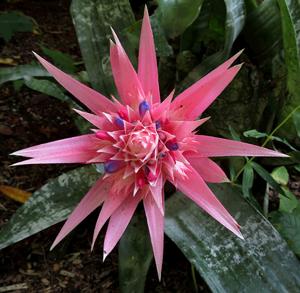
Natural Habitat and Ecosystem Role: Bromeliads in the Global Environment
Native Geographic Regions
Bromeliads originate from the Americas spanning:
- Central America: Primarily Costa Rica, Panama
- South America:
- Amazon Rainforest
- Brazilian Atlantic Rainforest
- Andean mountain regions
- Caribbean Islands: Significant biodiversity hotspots
- North America: Southern regions of the United States
Tropical and Subtropical Environments
These plants live in diverse ecosystems:
- Rainforest canopies
- Cloud forests
- Dry tropical forests
- Mountain slopes
- Coastal regions
- Semi-arid landscapes
Ecological Importance
Bromeliads serve critical ecosystem functions:
- Biodiversity Support:
- Provide habitat for microorganisms
- Create ecosystems within their water-collecting structures
- Support complex food webs
- Microclimate Regulation:
- Capture and store moisture
- Reduce soil erosion
- Moderate local temperature and humidity
Interactions with Wildlife
Bromeliads create ecological relationships:
Fauna Interactions
- Amphibian Habitats:
- Breeding grounds for poison dart frogs
- Offer water and shelter for small reptiles
- Insect Ecosystems:
- Support insect populations
- Create nurseries for larvae
- Host microorganism communities
Pollination Dynamics
- Attract specialized pollinators:
- Hummingbirds
- Specific moth species
- Specialized beetle populations
- Develop co-evolutionary relationships

Growing Bromeliads: Comprehensive Care Guide for Enthusiasts
Indoor Bromeliad Care
Light Requirements
Bromeliads have light preferences that vary by species:
- Low to Moderate Light Species:
- Guzmania
- Some Neoregelia varieties
- Ideal for indoor spaces with filtered light
- Bright, Indirect Light Species:
- Aechmea
- Vriesea
- Need protection from direct sunlight
- Recommended light exposure: 4-6 hours of filtered sunlight daily
Temperature Preferences
- Optimal temperature range: 55-85°F (13-29°C)
- Avoid sudden temperature fluctuations
- Species thrive in consistent indoor temperatures
- Protect from cold drafts and extreme heat
Humidity Needs
Factors for bromeliad health:
- Ideal humidity: 50-60%
- Methods to increase indoor humidity:
- Pebble trays
- Occasional misting
- Grouping plants together
- Using a humidifier
- Check humidity with a hygrometer
Watering Techniques
Watering strategies for bromeliads:
- Cup Method:
- Fill central cup/tank
- Change water weekly
- Prevent stagnation
- Soil Watering:
- Keep soil moist
- Avoid waterlogging
- Allow partial drying between waterings
- Use filtered or rainwater
Soil and Potting Requirements
Specialized potting needs:
- Ideal Soil Mix:
- Orchid bark
- Perlite
- Sphagnum moss
- Minimal organic matter
- Use well-draining containers
- Ensure drainage holes
- Avoid standard potting soil

Outdoor Bromeliad Cultivation
Landscape Design Considerations
- Create microclimate environments
- Use natural shade structures
- Group plants with similar requirements
- Vertical gardening techniques
Hardiness Zones
Bromeliad adaptability varies:
- Most suitable: Zones 9-11
- Some varieties tolerate zone 8
- Requires winter protection in cooler regions
Microclimate Requirements
- Partial shade
- Protection from harsh winds
- Consistent moisture
- Minimal direct afternoon sunlight
Sun Exposure Recommendations
- Morning sun, afternoon shade
- Filtered light through tree canopies
- Rotate plants to ensure even light exposure
- Use shade cloth in intense sunlight
Common Challenges in Bromeliad Care
Pest Management
Common bromeliad pests:
- Spider mites
- Mealybugs
- Scale insects
- Aphids
Prevention Strategies:
- Regular inspection
- Neem oil treatments
- Insecticidal soap
- Maintaining plant health
Disease Prevention
Potential health issues:
- Root rot
- Fungal infections
- Bacterial growth
- Viral diseases
Mitigation Techniques:
- Proper drainage
- Avoid overwatering
- Maintain good air circulation
- Sterilize tools between plant care
Troubleshooting Growth Issues
Common problems and solutions:
- Yellowing leaves: Adjust light exposure
- Brown leaf tips: Improve humidity
- Lack of flowering: Check nutrient levels
- Stunted growth: Check environmental conditions
Nutrient Deficiencies
Bromeliad nutritional needs:
- Low nutrient requirements
- Occasional liquid fertilizer
- Diluted, balanced fertilizer
- Apply during active growth periods
Propagation Techniques: Expanding Your Bromeliad Collection
Bromeliad propagation offers many methods each with advantages and challenges.
Pup Separation Method
The most common and straightforward propagation technique:
What are Pups?
- Smaller offspring plants
- Develop around the base of mature bromeliads
- Genetically identical to the parent plant
- Natural reproduction mechanism
Pup Separation Process
- Wait until the pup reaches 1/3 to 1/2 parent plant size
- Ensure the pup has developed its root system
- Use clean, sharp sterilized cutting tools
- Carefully separate from the mother plant
- Allow cut surfaces to callus for 24-48 hours
- Plant in appropriate bromeliad potting mix
Best Practices
- Propagate during active growing season
- Maintain consistent humidity
- Provide indirect light during recovery
- Check for potential stress or infection
Seed Propagation
A challenging and rewarding method:
Seed Collection
- Collect seeds from mature flower spikes
- Requires specific environmental conditions
- Most successful with controlled greenhouse environments
Seed Germination Steps
- Use sterile, well-draining seed-starting mix
- Maintain consistent moisture
- Keep temperature between 70-80°F
- Provide indirect light
- Use a clear plastic cover for humidity
- Expect slow germination (weeks to months)
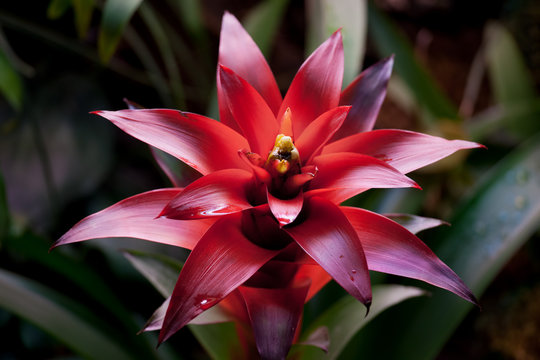
Bromeliad Environments: Choosing the Perfect Plant
Best Bromeliads for Beginners
Top Beginner-Friendly Species
- Guzmania lingulata
- Extremely tolerant of indoor conditions
- Vibrant red and orange flower spikes
- Minimal care requirements
- Neoregelia carolinae
- Stunning color-changing foliage
- Adapts to various light conditions
- Compact growth habit
- Tillandsia xerographica
- Low-maintenance air plant
- Unique sculptural appearance
- Requires minimal watering
Low-Light Bromeliads
For indoor spaces with limited natural light:
Recommended Varieties
- Guzmania varieties
- Some Vriesea species
- Cryptanthus (Earth Stars)
- Billbergia nutans
Characteristics:
- Thrive in indirect or filtered light
- Tolerant of artificial indoor lighting
- Maintain vibrant colors with minimal sunlight
- Ideal for offices and interior spaces
High-Humidity Loving Species
Bromeliads for humid environments:
Top Humidity-Loving Varieties
- Aechmea fasciata
- Thrives in bathroom environments
- Pink flower bracts
- Dramatic leaf patterns
- Vriesea splendens
- Neoregelia marmorata
- Tropical tank bromeliads
Optimal Conditions:
- Humidity levels 60-80%
- Consistent moisture
- Protection from direct air currents
Drought-Tolerant Varieties
Bromeliads for dry environments:
Drought-Resistant Species
- Tillandsia xerographica
- Survives extended periods without water
- Native to dry forest regions
- Minimal moisture requirements
- Dyckia species
- Some Hechtia varieties
- Puya raimondii
Survival Strategies:
- Specialized water storage mechanisms
- Reduced transpiration
- Thick, waxy leaf surfaces
- CAM photosynthesis adaptation
Indoor vs. Outdoor Recommendations
Indoor Bromeliad Selection
Best Choices:
- Guzmania
- Neoregelia
- Smaller Tillandsia varieties
- Cryptanthus
Key Considerations:
- Light availability
- Temperature consistency
- Humidity levels
- Space constraints
Outdoor Bromeliad Selection
Recommended Varieties:
- Aechmea
- Larger Vriesea species
- Landscape-friendly Neoregelia
- Hardier Tillandsia types
Planting Considerations:
- Hardiness zone compatibility
- Shade requirements
- Protection from extreme temperatures
- Soil and drainage conditions
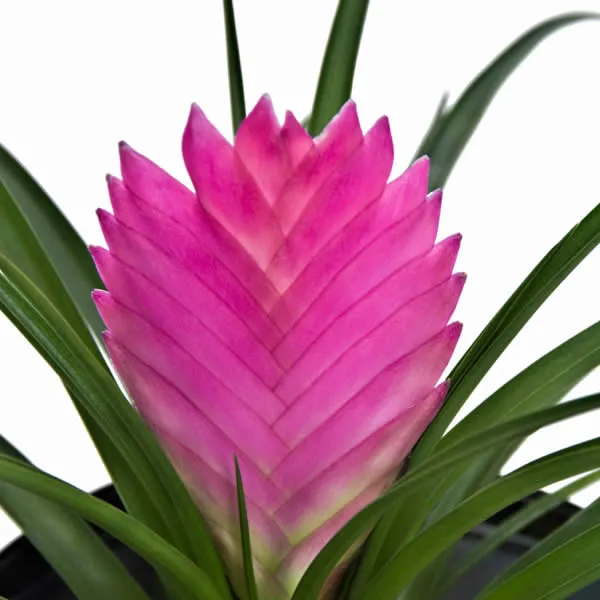
Decorative and Ornamental Uses: Transforming Spaces
Interior Design with Bromeliads
Bromeliads offer versatility in interior decor:
Design Strategies
- Create focal points in living spaces
- Unexpected color and texture
- Complement modern and traditional design schemes
- Bring natural elements indoors
Placement Techniques:
- Centerpiece arrangements
- Shelf and mantle displays
- Floating shelves
- Desk and workspace accents
Color and Texture Considerations
- Vibrant foliage colors
- Unique leaf patterns
- Architectural plant structures
- Seasonal color variations
Vertical Garden Applications
Innovative ways to incorporate bromeliads:
Vertical Garden Design
- Living wall installations
- Mounted plant displays
- Hanging garden configurations
- Modular green wall systems
Benefits:
- Space-efficient plant display
- Improved indoor air quality
- Visual interest
- Architectural enhancement
Terrarium Design
Creating miniature ecosystems:
Terrarium Types
- Glass Enclosed
- Sealed environments
- Controlled moisture
- Open Terrariums
- Better air circulation
- Easier maintenance
Recommended Bromeliad Species:
- Tillandsia
- Small Neoregelia varieties
- Miniature Guzmania
- Cryptanthus
Floral Arrangements
Bromeliad incorporation:
Arrangement Techniques
- Long-lasting flower spikes
- Dramatic centerpieces
- Wedding and event decor
- Tropical-themed compositions
Design Considerations:
- Color coordination
- Texture contrast
- Structural elements
- Seasonal variations
Landscape Design Ideas
Outdoor bromeliad integration:
Landscape Strategies
- Rock garden installations
- Tropical garden themes
- Understory plantings
- Container garden collections
Design Principles:
- Layered planting
- Microclimate creation
- Architectural plant placement
- Seasonal interest
Psychological and Wellness Benefits
Decorative bromeliad uses beyond aesthetics:
- Reduce stress
- Improve indoor air quality
- Create calming environments
- Enhance mental well-being
- Connect interior spaces with nature
Cultural Design Influences
- Tropical design aesthetics
- Minimalist Japanese-inspired arrangements
- South American botanical traditions
- Contemporary ecological design principles
Cultural Significance: Botanical Boundaries
Historical Uses
Bromeliads have played roles in cultures for centuries:
Indigenous Cultural Importance
- Amazonian Tribes:
- Medicinal applications
- Ceremonial significance
- Water collection tools
- Caribbean Cultures:
- Spiritual symbolism
- Traditional healing practices
- Decorative and practical uses
Pre-Columbian Civilizations
- Aztec and Inca societies used bromeliads for:
- Food production
- Textile fiber extraction
- Ritual and ceremonial purposes
- Architectural and decorative elements
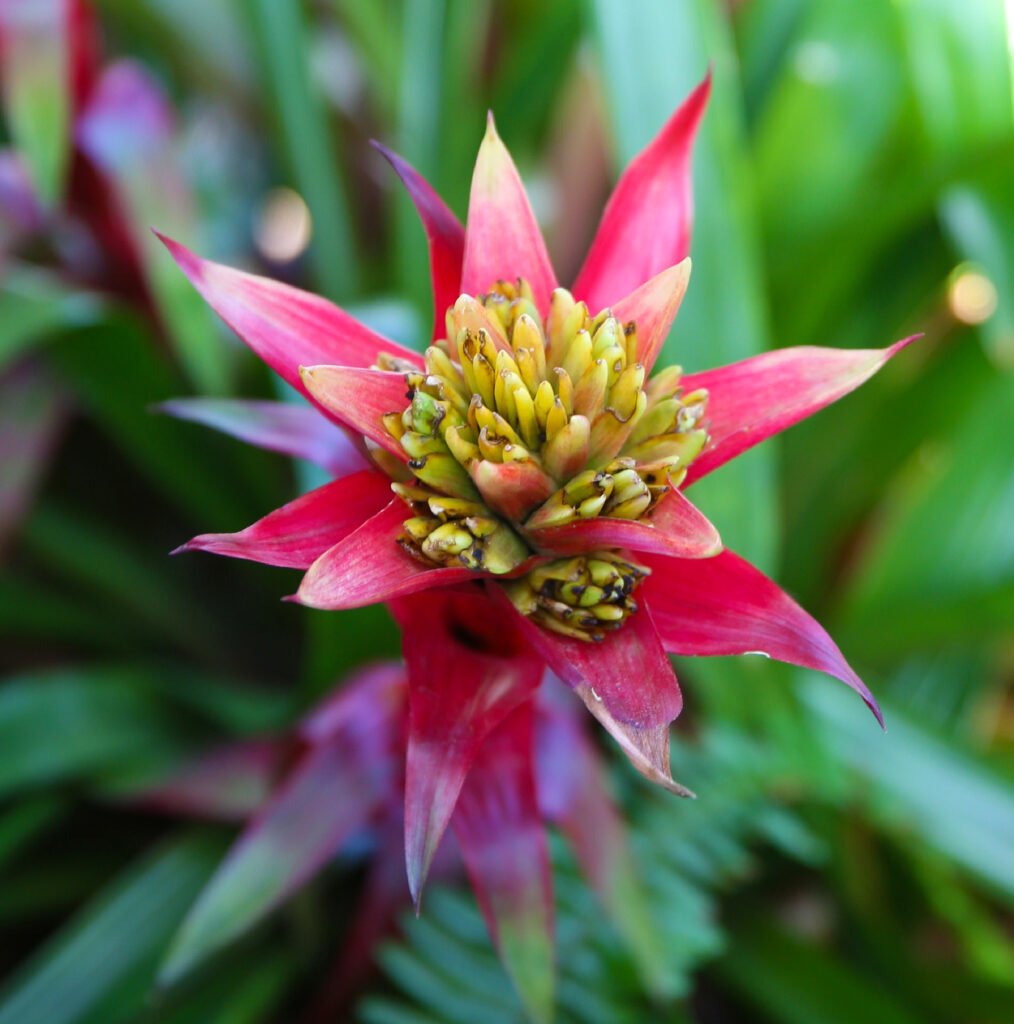
Conclusion: Extraordinary World of Bromeliads
Bromeliad Significance Recap
Bromeliads are far more than simple plants:
- Living testaments to evolutionary adaptation
- Critical components of global ecosystems
- Sources of scientific inspiration
- Beautiful botanical wonders
Key Takeaways
Botanical Marvels
- Incredibly diverse plant family
- Over 3,500 unique species
- Remarkable survival capabilities
- Found across many continents
Ecological Importance
- Support complex ecosystem networks
- Provide critical microhabitats
- Show extraordinary adaptability
- Contribute to global biodiversity
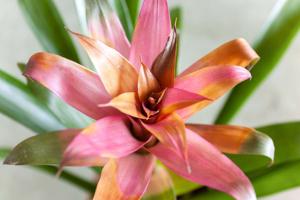
Frequently Asked Questions (FAQs)
Common Bromeliad Care Questions
1. How often should I water my bromeliad?
- Fill the central cup weekly
- Allow soil to dry between waterings
- Use filtered or rainwater
- Avoid overwatering
2. Do bromeliads need direct sunlight?
- Most prefer indirect, filtered light
- Avoid harsh direct sunlight
- Varies by specific species
- Check the plant’s response
3. How long do bromeliads live?
- Average lifespan: 3-5 years
- Some species can live longer
- Depends on care and environment
- Pups can continue the plant’s legacy
4. Are bromeliads difficult to grow?
- Many are beginner-friendly
- Need specific but manageable care
- Choose appropriate species
- Learn individual plant needs
5. Can bromeliads grow indoors?
- Excellent indoor plants
- Many thrive in controlled environments
- Select appropriate varieties
- Provide proper light and humidity
6. How do I propagate bromeliads?
- Pup separation is the most common method
- Wait until the pup is 1/3 to 1/2 parent size
- Ensure a developed root system
- Use sterile cutting tools
7. What are common bromeliad problems?
- Overwatering
- Insufficient light
- Pest infestations
- Improper humidity